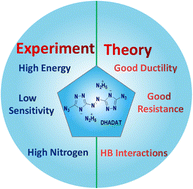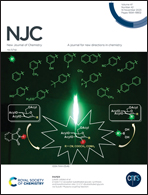Exploring high-energy and low-sensitivity energetic compounds based on experiments and DFT studies†
Abstract
To date, it has become more and more important to design and synthesize energetic materials that have a good balance between energy and safety. In this study, a new nitrogen-rich energetic compound with high energy and low sensitivity is designed and synthesized. The target compound dihydrazinium 3,3′-azo-5,5′-diazido-1,2,4-triazol (DHADAT) shows a very high nitrogen content (81.27%) and high enthalpy of formation (1405 kJ mol−1). Furthermore, DHADAT not only exhibits a detonation velocity (D = 9122 m s−1) comparable to HMX, but also has a much lower impact sensitivity (IS = 23 J) than HMX (D = 9144 m s−1, IS = 7.4 J). Additionally, a calculation based on dispersion-corrected density functional theory (DFT-D) has been performed to examine the electronic and mechanical properties of DHADAT. And the analysis of the density of states and the Hirshfeld surface indicates that the N–H⋯N hydrogen bonding interaction plays a vital role in stabilizing the whole system. And it is discovered through the analysis of the mechanical properties that this compound exhibits a better ductility, resistance to deformation and stiffness than HMX. The systematic research on DHADAT by combining experiment and theory ensures that DHADAT could be an extremely promising insensitive high-energy material.



 Please wait while we load your content...
Please wait while we load your content...